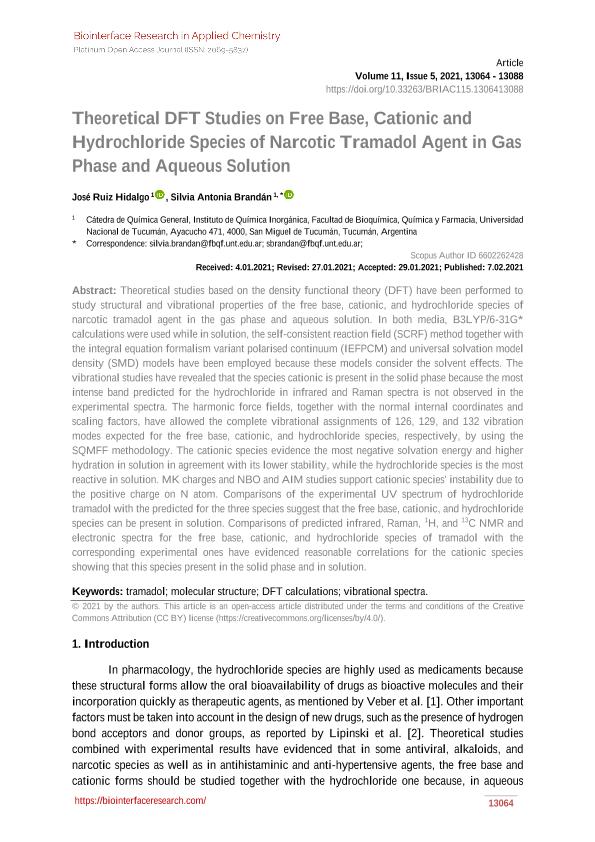Mostrar el registro sencillo del ítem
dc.contributor.author
Ruiz Hidalgo, José

dc.contributor.author
Brandan, Silvia Antonia

dc.date.available
2022-09-29T14:15:46Z
dc.date.issued
2021-02
dc.identifier.citation
Ruiz Hidalgo, José; Brandan, Silvia Antonia; Theoretical DFT studies on free base, cationic and hydrochloride species of narcotic tramadol agent in gas phase and aqueous solution; AMG Transcend Association; Biointerface Research in Applied Chemistry; 11; 5; 2-2021; 13064-13088
dc.identifier.issn
2069-5837
dc.identifier.uri
http://hdl.handle.net/11336/171003
dc.description.abstract
Theoretical studies based on the density functional theory (DFT) have been performed to study structural and vibrational properties of the free base, cationic, and hydrochloride species of narcotic tramadol agent in the gas phase and aqueous solution. In both media, B3LYP/6-31G* calculations were used while in solution, the self-consistent reaction field (SCRF) method together with the integral equation formalism variant polarised continuum (IEFPCM) and universal solvation model density (SMD) models have been employed because these models consider the solvent effects. The vibrational studies have revealed that the species cationic is present in the solid phase because the most intense band predicted for the hydrochloride in infrared and Raman spectra is not observed in the experimental spectra. The harmonic force fields, together with the normal internal coordinates and scaling factors, have allowed the complete vibrational assignments of 126, 129, and 132 vibration modes expected for the free base, cationic, and hydrochloride species, respectively, by using the SQMFF methodology. The cationic species evidence the most negative solvation energy and higher hydration in solution in agreement with its lower stability, while the hydrochloride species is the most reactive in solution. MK charges and NBO and AIM studies support cationic species' instability due to the positive charge on N atom. Comparisons of the experimental UV spectrum of hydrochloride tramadol with the predicted for the three species suggest that the free base, cationic, and hydrochloride species can be present in solution. Comparisons of predicted infrared, Raman,1H, and13 C NMR and electronic spectra for the free base, cationic, and hydrochloride species of tramadol with the corresponding experimental ones have evidenced reasonable correlations for the cationic species showing that this species present in the solid phase and in solution.
dc.format
application/pdf
dc.language.iso
eng
dc.publisher
AMG Transcend Association
dc.rights
info:eu-repo/semantics/openAccess
dc.rights.uri
https://creativecommons.org/licenses/by/2.5/ar/
dc.subject
DFT CALCULATIONS
dc.subject
MOLECULAR STRUCTURE
dc.subject
TRAMADOL
dc.subject
VIBRATIONAL SPECTRA
dc.subject.classification
Química Inorgánica y Nuclear

dc.subject.classification
Ciencias Químicas

dc.subject.classification
CIENCIAS NATURALES Y EXACTAS

dc.title
Theoretical DFT studies on free base, cationic and hydrochloride species of narcotic tramadol agent in gas phase and aqueous solution
dc.type
info:eu-repo/semantics/article
dc.type
info:ar-repo/semantics/artículo
dc.type
info:eu-repo/semantics/publishedVersion
dc.date.updated
2022-09-19T20:35:28Z
dc.journal.volume
11
dc.journal.number
5
dc.journal.pagination
13064-13088
dc.journal.pais
Rumania

dc.description.fil
Fil: Ruiz Hidalgo, José. Consejo Nacional de Investigaciones Científicas y Técnicas. Centro Científico Tecnológico Conicet - Tucumán; Argentina. Universidad Nacional de Tucuman. Facultad de Bioquimica, Quimica y Farmacia. Instituto de Quimica Inorganica. Cátedra de Química General.; Argentina
dc.description.fil
Fil: Brandan, Silvia Antonia. Universidad Nacional de Tucuman. Facultad de Bioquimica, Quimica y Farmacia. Instituto de Quimica Inorganica. Cátedra de Química General.; Argentina
dc.journal.title
Biointerface Research in Applied Chemistry
dc.relation.alternativeid
info:eu-repo/semantics/altIdentifier/url/https://biointerfaceresearch.com/?page_id=7490
dc.relation.alternativeid
info:eu-repo/semantics/altIdentifier/doi/http://dx.doi.org/10.33263/BRIAC115.1306413088
Archivos asociados
